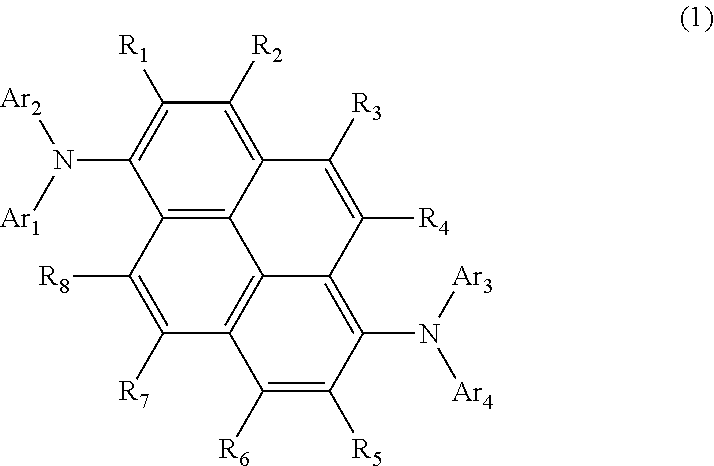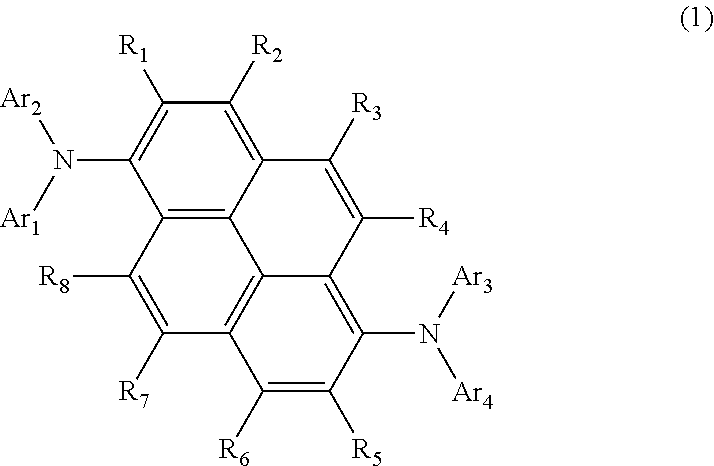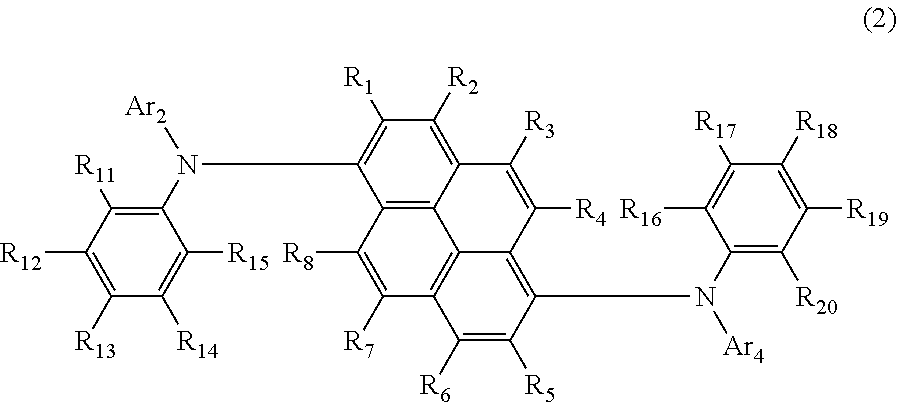Aromatic amine derivative and organic electroluminescent element using same
- Summary
- Abstract
- Description
- Claims
- Application Information
AI Technical Summary
Benefits of technology
Problems solved by technology
Method used
Image
Examples
example 1
[0196]An aromatic amine derivative DM-1 was produced as below.
(1) Synthesis of 4-cyanophenylphenylamine
[0197]Under a flow of argon, in a 300 mL-recovery flask, 20 g of 4-bromobenzonitrile, 30 mL of aniline, 1.50 g of tris(dibenzylideneacetone)dipalladium(0)[Pd2(dba)3], 2.1 g of 2,2′-bis(diphenylphosphino)-1,1′-binaphthyl[BINAP], 21.1 g of sodium tert-butoxide and 313 mL of dehydrated toluene were placed, and reacted at 85° C. for 6 hours.
[0198]After cooling, the reaction solution was filtered through celite. The crude product obtained was purified by means of silica-gel chromatography, and resulting solids were dried under reduced pressure, whereby 14.9 g of white solids were obtained (yield 70%).
(2) Synthesis of DM-1
[0199]Under a flow of argon, in a 300 mL-recovery flask, 7.2 g of 4-cyanophenylphenylamine, 5.7 g of 1,6-dibromo-3,8-dimethylpyrene, 2.8 g of sodium tert-butoxide, 160 mg of palladium(II)acetate [Pd(OAc)2], 135 mg of tri-tert-butylphosphine and 73 mL of dehydrated tolue...
example 2
[0201]As shown below, an aromatic amine derivative DM-2 was produced in the same manner as in Example 1, except that 1,6-dibromo-3,8-diisopropylpyrene was used instead of 1,6-dibromo-3,8-dimethylpyrene. As a result of mass spectroscopy analysis, the resulting compound was confirmed to be an intended product, which had an m / e of 670 for the molecular weight 670.31.
example 3
[0202]An aromatic amine derivative DM-3 was produced as below.
(1) Synthesis of N-(4-(trimethylsilyl)phenyl)acetamide
[0203]Under a flow of argon, in a 1 L-recovery flask, 35 g of 1-bromo-4-(trimethylsilyl)benzene, 22.6 g of acetamide, 5.8 g of copper(I)iodide, 42.2 g of potassium carbonate, and 380 mL of xylene were placed. After stirring, 6.6 mL of N,N′-dimethylethylenediamine was added. The resultant was heated and stirred at reflux for 18 hours.
[0204]The reaction solution was filtered. The crude product obtained was washed with toluene, clean water and methanol. Resulting solids were dried under reduced pressure, whereby 27 g of solids were obtained.
(2) Synthesis of N-(4-cyanophenyl)-N-(4-(trimethylsilyl)phenyl)acetamide
[0205]Under a flow of argon, in a 1 L-recovery flask, 27 g of N-(4-(trimethylsilyl)phenyl)acetamide, 30 g of 4-bromobenzonitrile, 6.3 g of copper (I) iodide, 45.6 g of potassium carbonate, and 412 mL of xylene were placed. After stirring, 7.1 mL of N,N′-dimethyleth...
PUM
| Property | Measurement | Unit |
|---|---|---|
| Fraction | aaaaa | aaaaa |
| Fraction | aaaaa | aaaaa |
| Fraction | aaaaa | aaaaa |
Abstract
Description
Claims
Application Information
 Login to View More
Login to View More - R&D
- Intellectual Property
- Life Sciences
- Materials
- Tech Scout
- Unparalleled Data Quality
- Higher Quality Content
- 60% Fewer Hallucinations
Browse by: Latest US Patents, China's latest patents, Technical Efficacy Thesaurus, Application Domain, Technology Topic, Popular Technical Reports.
© 2025 PatSnap. All rights reserved.Legal|Privacy policy|Modern Slavery Act Transparency Statement|Sitemap|About US| Contact US: help@patsnap.com



